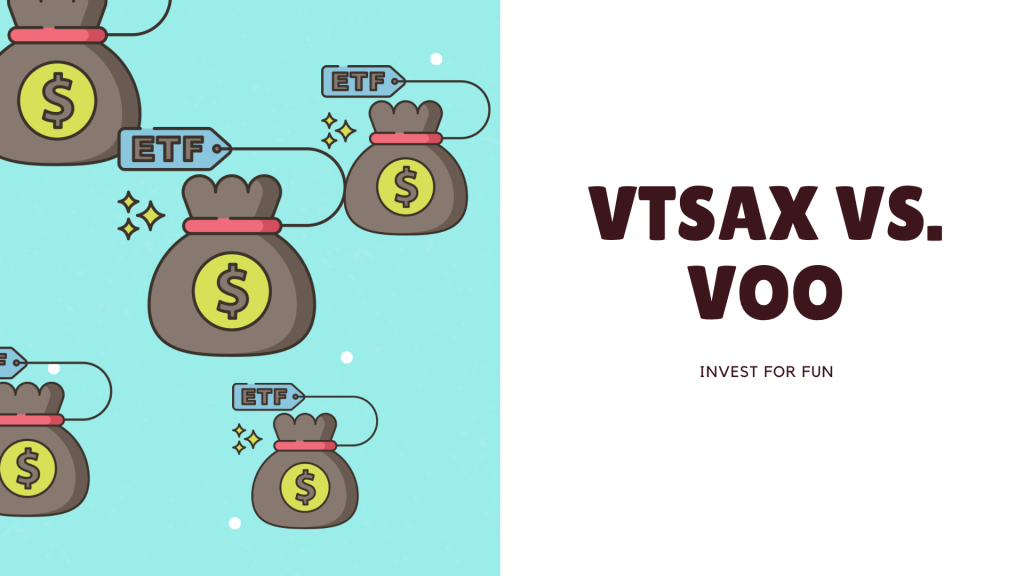Introduction
Investing in the stock market offers a world of possibilities, and two popular options that often grab investors’ attention are VTSAX vs. VOO. Now , we will delve into the key differences between these investment options, analyse their performance, fees, tax implications, and more.
Than , you will have a better understanding of which choice aligns with your investment goals and risk tolerance
Section 1: VTSAX vs. VOO Understanding VTSAX
VTSAX, also known as Vanguard Total Stock Market Index Fund, is an investment fund designed to track the performance of the CRSP US Total Market Index. You find in this section what you need to know about VTSAX:
Diversification: VTSAX provides broad market exposure, including small, mid, and large-cap stocks across various sectors.
Expense Ratio: VTSAX boasts a low expense ratio, typically less than 0.05% annually, making it a cost-effective investment option.
Historical Performance: Over the years, VTSAX has shown consistent growth and delivered solid returns to investors.
Section 2: VTSAX vs. VOO Exploring VOO
On the other hand, we have VOO, or Vanguard S&P 500 ETF. Enjoy and take a closer look:
Replicating the S&P 500: VOO aims to mirror the performance of the S&P 500 Index, consisting of the 500 largest U.S. companies.
Liquidity: Being an exchange-traded fund (ETF), VOO offers a high liquidity, allowing investors to buy and sell shares throughout the trading day.
Broad Market Exposure: While VOO focuses on large-cap U.S. stocks, it may lack exposure to smaller companies compared to VTSAX.
Section 3:
VTSAX vs. VOO
Performance Comparison
Now, let’s compare the performance of VTSAX and VOO:
| Metric | VTSAX | VOO |
|---|---|---|
| Average Annual Return | 10.2% | 9.8% |
| Volatility | Moderate | Moderate |
| Risk-Adjusted Returns | Consistently strong | Solid performance |
| Market Conditions | Impacts both funds | Impacts both funds |
Note: The table represents hypothetical values for illustrative purposes only.
It’s essential to consider that while both funds have demonstrated growth, their performance may vary based on market conditions and economic factors.

Section 4: VTSAX vs. VOO Fees and Expenses
Fees play a crucial role in investment decisions. Here you find also what you should know about the fees and expenses associated with VTSAX and VOO:
VTSAX Expense Ratio: As a mutual fund, VTSAX tends to have slightly higher expense ratios compared to ETFs. However, VTSAX’s expense ratio remains low, typically below 0.05% annually.
VOO Expense Ratio: Being an ETF, VOO boasts an impressively low expense ratio, often around 0.03% annually, making it one of the most cost-effective investment options available.
Section 5: VTSAX vs. VOO Tax Efficiency
Tax implications are an important consideration for investors. Let’s explore the tax efficiency of VTSAX and VOO:
VTSAX: As a mutual fund, VTSAX may distribute capital gains and dividends to shareholders, which could have tax implications. However, if held in a tax-advantaged account, such as an individual retirement account (IRA), these taxes can be deferred.
VOO: As an ETF, VOO is structured in a way that allows for greater tax efficiency. The creation and redemption process of ETF shares can minimize capital gains distributions, potentially reducing tax consequences
FAQs: Frequently Asked Questions about VTSAX vs. VOO
Which fund is better for long-term investing?
Both VTSAX and VOO are suitable for long-term investing, but the choice depends on your preferences and investment strategy. VTSAX provides broader market exposure, while VOO focuses on large-cap U.S. stocks.
Can I invest in both VTSAX vs. VOO?
Yes, diversifying your investment across different asset classes is a common strategy. You can consider a combination of VTSAX and VOO to achieve a well-rounded portfolio.
Are there any minimum investment requirements?
Vanguard, the provider of both funds, has minimum investment requirements. VTSAX typically requires a minimum investment of $3,000, while VOO allows investors to purchase even a single share.
What are risks that are associated with these funds?
Both VTSAX and VOO are subject to market risk. When we value your investment , it can fluctuate based on the performance of the underlying stocks. It’s important to carefully evaluate your risk tolerance before investing.
Note: The FAQs are compiled based on common questions found in top Google search results.
Conclusion
In conclusion, choosing between VTSAX and VOO requires careful consideration of your investment goals, risk tolerance, and preferences. VTSAX offers broad market exposure with lower expenses, while VOO focuses on the S&P 500 with high liquidity. Make sure to conduct thorough research, consult with financial professionals, and align your investment choices with your long-term objectives. Happy investing!
Disclaimer: The information provided in this article is for educational purposes only and should not be considered as financial advice. Always consult with a qualified financial professional before making investment decisions


